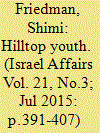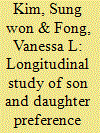|
|
|
Sort Order |
|
|
|
Items / Page
|
|
|
|
|
|
|
| Srl | Item |
| 1 |
ID:
101298


|
|
|
|
|
| Publication |
2010.
|
| Summary/Abstract |
This article attempts to explain the growing popularity of private religious lessons in urban Tajikistan from a cross-generational perspective. By instilling discipline and good 'morals', religious lessons serve as a powerful tool to socialize adolescent and morally vulnerable urban youth into the established social order. The increasing demand for religious instruction on the part of Muslim parents not only reflects the growing importance of Islam in Tajikistan, but also highlights the weaknesses of state education and the constraints on family upbringing in neo-local urban households. By attending religious classes, male and female youth have found a space for negotiating religious identities and for realizing their own abilities and ambitions. Given the socio-economic hardships of everyday life in the post-Soviet city, a turn to Islam can promote integration, recognition and social mobility, and offer an alternative route for urban youth to become 'adults'.
|
|
|
|
|
|
|
|
|
|
|
|
|
|
|
|
| 2 |
ID:
139244


|
|
|
|
|
| Summary/Abstract |
In the first decade of this century, a new social group, popularly called the ‘hilltop youth’, came to the attention of Israeli society. This group consisted of a small number of young people who took part in aggressive political actions including illegal settlement endeavours throughout Judea and Samaria. Before their arrival at the various wilderness outposts, these youth had not developed any political outlook in regard to Jewish settlement in these areas; it was only during their period of habitation did they tend to adopt and utilize views informed by ideological and cultural extremism. The manifestation of this socio-political phenomenon will be analysed from sociological and anthropological perspectives in order to shed light on social aspects of Israeli society, as well as to elucidate frequently unclear political and policy implications in the larger Middle Eastern context. In addition, this article describes the significance of a youth subculture that has emerged in this frontier political space, and which has often been cast in criminological terms. To buttress the claims advanced in this study, a psychological-sociological approach is also employed.
|
|
|
|
|
|
|
|
|
|
|
|
|
|
|
|
| 3 |
ID:
130432


|
|
|
|
|
| Publication |
2014.
|
| Summary/Abstract |
In this mixed-method longitudinal study, we examined the continuity of son preference and daughter preference from adolescence to adulthood, and investigated how perceptions of gender equity shape these preferences among 2,273 youth born in Dalian between 1979 and 1986 under the one-child policy. The majority expressed no preference in adolescence or adulthood. Results from multivariate analysis and the narratives of 23 participants revealed that child gender preferences in adolescence were predictive of later preferences in adulthood. Furthermore, in adolescence, child gender preferences were associated with individuals' beliefs about gender as manifested in their attitudes towards women and employment, as well as their perceptions of parental and social gender biases against women. Our findings suggest that increasingly gender-egalitarian attitudes in urban China shape the child gender preferences of singleton youth in adolescence, and are likely to contribute to their later childbearing decisions, with important social and demographic implications.
|
|
|
|
|
|
|
|
|
|
|
|
|
|
|
|
| 4 |
ID:
181413


|
|
|
|
|
| Summary/Abstract |
This article discusses social and legal problems of the mental health of the population of Russia and China using the example of depressive disorders spectrum. The urgency of the problem is due to the wide diffusion of the disease, the difficulty of early diagnosis, and the growing risk of suicide; it is of great importance in most countries. A comparative analysis of legal problems in the two countries in the field of mental health prevention, conducted at macrosocial levels through parallel sociological and psychological studies in Khabarovsk Territory (Russia) and Heilongjiang Province (China), shows a significant difference in the state approaches of the adjacent countries of the Far East. In Heilongjiang Province, the adolescent depression prevention model has been implemented and is highly effective.
|
|
|
|
|
|
|
|
|
|
|
|
|
|
|
|
| 5 |
ID:
175730


|
|
|
|
|
| Summary/Abstract |
The overwhelming majority of jihadists identified in Australia across the last two decades form an interconnected network which transcends time and geographic locations. Close peer relationships appear key to understanding how Australian jihadists recruit and how the network evolves. More recently the Australian network has grown significantly, and with this increase in size has come a concurrent escalation in the level of threat posed. This article analyses the factors that have coalesced together to drive this increase. In doing so, it challenges some underlying assumptions regarding radicalisation in Australia that may not be backed by empirical research, or are based on anomalous case studies not representative of the larger network. It also highlights the recent emergence of a new cohort of Australian jihadists: teenagers. An analysis of the emergence of these teenage jihadists is then conducted, along with a discussion of the implications for policing strategies and the future of countering violent extremism programs in Australia.
|
|
|
|
|
|
|
|
|
|
|
|
|
|
|
|
|
|
|
|
|